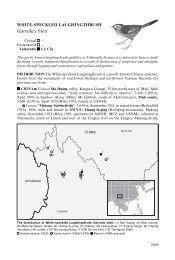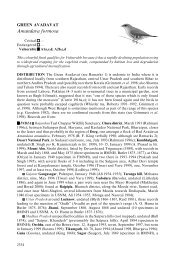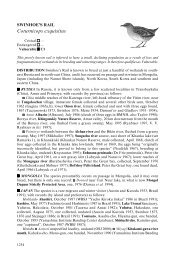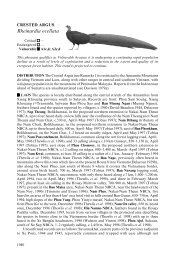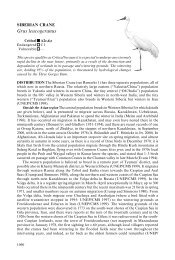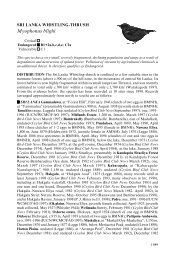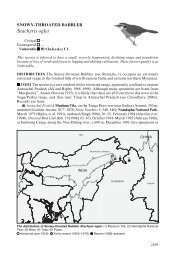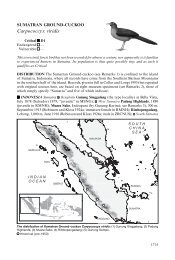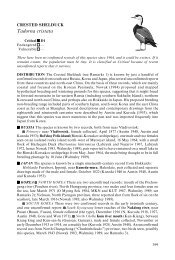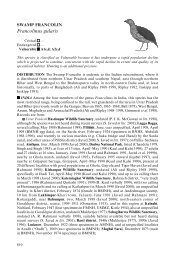Ptilinopus arcanus - BirdBase
Ptilinopus arcanus - BirdBase
Ptilinopus arcanus - BirdBase
Create successful ePaper yourself
Turn your PDF publications into a flip-book with our unique Google optimized e-Paper software.
NEGROS FRUIT-DOVE<br />
<strong>Ptilinopus</strong> <strong>arcanus</strong><br />
Critical D1<br />
Endangered —<br />
Vulnerable D2<br />
This species is one of the least known birds in the world. It remains known only from the site where<br />
it was discovered in 1953 and, despite several recent protracted ornithological visits, it has not<br />
been recorded since. It is therefore inferred to have a tiny population, qualifying it as Critical.<br />
DISTRIBUTION The Negros Fruit-dove is endemic to Negros in the Philippines, or at least<br />
only known from that island; but given the recent discovery on Panay of threatened species<br />
which, until 10 years ago, were known only from Negros and sometimes Guimaras (Negros<br />
Bleeding-heart Gallicolumba keayi, Flame-templed Babbler Dasycrotapha speciosa and Whitethroated<br />
Jungle-flycatcher Rhinomyias albigularis) there is every reason to suppose that this<br />
mysterious fruit-dove may also prove to be present there.<br />
■ PHILIPPINES Negros The species is known only from the female type collected along<br />
with a second bird, presumed its mate but whose body was lost in the undergrowth, on Mt<br />
Canlaon at Pula (Pulopantao), on 1 May 1953 (Ripley and Rabor 1955; specimen in YPM;<br />
see Remarks 1).<br />
POPULATION The Negros Fruit-dove is the least known bird in the Philippines and one of<br />
the least known in the world. Its population is unknown, but given the failure of any<br />
investigator to encounter the species since its discovery in 1953, it must be an extremely rare<br />
bird. Brooks et al. (1992) and Evans et al. (1993a) reported that despite spending nine days at<br />
the type locality and a further 11 days at other sites in the same range of mountains, P.<br />
<strong>arcanus</strong> was not encountered. Similarly, a survey of Mt Canlaon in March 1994 was<br />
unsuccessful (P. L. Alviola verbally 1995).<br />
PANAY<br />
BANTAYAN<br />
CEBU<br />
GUIMARAS<br />
1<br />
NEGROS<br />
S U L U S E A<br />
SIQUIJOR<br />
The distribution of Negros Fruit-dove <strong>Ptilinopus</strong><br />
<strong>arcanus</strong>: (1) Mt Canlaon.<br />
Fairly recent (1950–1979)<br />
1605
Threatened birds of Asia<br />
ECOLOGY Habitat The original description of the species reported that the type was “one<br />
of a pair shot out of a large fruiting tree on the edge of a camp clearing, at an altitude of<br />
3600 feet”, i.e. 1,090 m (Ripley and Rabor 1955). A slightly different version is that it was<br />
“taken from a tall tree growing on a ridge with a very deep ravine on one side...at about 3700<br />
feet elevation”, i.e. 1,120 m (Rabor 1964). Despite this, the species may have been chiefly a<br />
lowland bird, in which case it may well be extinct since no forest survives below 750 m in<br />
northern Negros (Brooks et al. 1992); indeed, both these points are discernible in Ripley and<br />
Rabor (1956), who indicated first that forests at 750–1,350 m “are halfway between the genuine<br />
lowland dipterocarp forest type... and the real mid-mountain forest type”, and second that<br />
below 900 m “the mountain slopes have been entirely cleared... so that actually the virgin<br />
forests begin about 3500 feet above sea level”, i.e. at that stage less than 100 m below the<br />
elevation at which the type was collected. Even if it could survive in the highlands, all pigeons<br />
and fruit-doves are hunted on Mt Canlaon, and its survival may be jeopardised by this (Brooks<br />
et al. 1992, Evans et al. 1993a).<br />
Food Nothing is known.<br />
Breeding Nothing is known.<br />
Migration Nothing is known.<br />
THREATS Hunting and habitat destruction may have already exterminated the species (Collar<br />
et al. 1994).<br />
MEASURES TAKEN Mt Canlaon is a CPPAP site (see Appendix). No other measures are<br />
known except that in the mid-1990s the species was featured on an environmental awareness<br />
poster focusing on pigeons as part of the “Only in the Philippines” series, funded by British<br />
Airways Assisting Conservation and FFI, with text in English and Tagalog (W. L. R. Oliver<br />
verbally 1998).<br />
MEASURES PROPOSED Because of the lack of data regarding the species’s status,<br />
requirements and distribution, it is not possible to formulate any specific conservation<br />
recommendations (although see comments under Negros Bleeding-heart Gallicolumba keayi).<br />
Continued fieldwork in suitable areas is a priority to determine whether the species is extant<br />
and, indeed, whether it is a valid taxon (see Remarks 1). If rediscovered, the species should<br />
be incorporated as a priority within a conservation strategy for the threatened birds of Negros<br />
(see equivalent section under Visayan Wrinkled Hornbill Aceros waldeni). Fieldworkers on<br />
Panay should be alert to the possibility that this species may be present in the lowest-lying<br />
remaining forest areas.<br />
REMARKS (1) An alternative explanation for the lack of records would be the possible<br />
invalidity of the species: its small size and atypical plumage suggest it might be a runt specimen<br />
of Yellow-breasted Fruit-dove <strong>Ptilinopus</strong> occipitalis or of a green-pigeon Treron; in one view<br />
the verdict must be postponed until the male is described (Mayr 1957; also Brooks et al.<br />
1992), although it might be possible to subject the type specimen to biochemical analysis.<br />
However, comforting as the notion may be that P. <strong>arcanus</strong> is invalid, the characters that define<br />
it seem to suggest otherwise, and its smallness is no guide, given the existence of the still<br />
smaller Dwarf Fruit-dove P. nanus.<br />
1606



